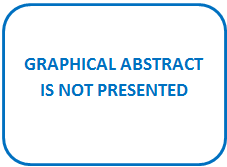The influence of agricultural land on the level of airborne Alternaria spores
DOI:
https://doi.org/10.15587/2519-8025.2023.287424Keywords:
aeromonitoring, airborne fungal spores, Alternaria, agricultural activity and spore level, crops, LOOCV, BICAbstract
Aim of the research was to investigate the impact of agricultural activity on the concentration of Alternaria spores.
Materials and methods. The study was carried out at the Department of Medical Biology, Parasitology and Genetics of the ZSMPhU. Samples were collected using a 7-day volumetric sampler of the Hirst type, using the volumetric method. Samples were identified under a light microscope, and spore identification and counting were limited to genus levels. The relationship between seasonal Alternaria spore levels and harvest rates was analysed using Pearson's correlation method. The effect of meteorological conditions and agricultural activity on the daily concentration of Alternaria was analysed using stepwise correlation based on logarithmically transformed daily average spore counts. Classical leave-one-out cross-validation (LOOCV) was used to estimate the mean square error (MSE), associated with this model and Bayesian information criterion (BIC) was used to assess its accuracy.
Results. Seasonal characteristics of Alternaria spores and agricultural activity in Zaporizhzhia and Dnipro regions were analysed. The connection of some seasonal and daily indicators with harvesting rates and meteorological conditions was determined. Two models with 5 and 9 parameters were found that best explain the dynamics of Alternaria spores.
Conclusions. The most significant parameters positively correlated with Alternaria spore levels were temperature, pressure, westerly wind and wheat yield; relative humidity was negatively correlated
References
- Reznik, Y. V., Yermishev, O. V., Palamarchuk, O. V., Bobrovska, O. A., Rodinkova, V. V. (2023). Features of the seasonal dynamics of airborne fungal spore concentrations in Ukraine. Biosystems Diversity, 31 (1), 71–83. doi: https://doi.org/10.15421/012308
- Havrylenko, K. V., Prykhodko, O. B., Liakh, V. O., Yemets, T. I. (2022). Aeromonitoring of Alternaria spores in the air of Zaporizhzhia city. Zaporozhye Medical Journal, 24 (3), 338–342. doi: https://doi.org/10.14739/2310-1210.2022.3.243836
- Jones, C. L. (2023). Environmental and clinical mould spore risk thresholds. Journal of Bacteriology & Mycology: Open Access, 11 (1), 44–48. doi: https://doi.org/10.15406/jbmoa.2023.11.00342
- Hughes, K. M., Price, D., Torriero, A. A. J., Symonds, M. R. E., Suphioglu, C. (2022). Impact of Fungal Spores on Asthma Prevalence and Hospitalization. International Journal of Molecular Sciences, 23 (8), 4313. doi: https://doi.org/10.3390/ijms23084313
- Nasser, S. M., Pulimood, T. B. (2009). Allergens and thunderstorm asthma. Current Allergy and Asthma Reports, 9 (5), 384–390. doi: https://doi.org/10.1007/s11882-009-0056-8
- Andersen, B., Sørensen, J. L., Nielsen, K. F., van den Ende, B. G., de Hoog, S. (2009). A polyphasic approach to the taxonomy of the Alternaria infectoria species–group. Fungal Genetics and Biology, 46 (9), 642–656. doi: https://doi.org/10.1016/j.fgb.2009.05.005
- Kolesnichenko, O. V. (2011). Otsinka stiikosti sortiv ripaku yaroho (Birassica napus L.) do alternariozu ta efektyvnist zastosuvannia funhitsydiv z Metoiu obmezhennia rozvytku khvoroby. Plant varieties studying and protection, 2 (14), 80–82. Available at: http://nbuv.gov.ua/UJRN/stopnsr_2011_2_20
- Polozhenets, V. M., Nemerytska, L. V., Zhuravska, I. A., Romaniuk, A. A., Melnychuk, V. V., Khodakivska, N. I. (2020). Prohnozuvannia rivnia sezonnoho rozvytku alternariozu kartopli v Polissi Ukrainy, Visnyk Zhytomyrskoho ahrotekhnichnoho koledzhu, 2 (1), 10–17. http://repozitory.zhatk.zt.ua//handle/123456789/170
- Apangu, G. P., Adams-Groom, B., Satchwell, J., Pashley, C. H., Werner, M., Kryza, M. et al. (2022). Sentinel-2 satellite and HYSPLIT model suggest that local cereal harvesting substantially contribute to peak Alternaria spore concentrations. Agricultural and Forest Meteorology, 326, 109156. doi: https://doi.org/10.1016/j.agrformet.2022.109156
- Rodríguez-Fernández, A., Blanco-Alegre, C., Vega-Maray, A. M., Valencia-Barrera, R. M., Molnár, T., Fernández-González, D. (2023). Effect of prevailing winds and land use on Alternaria airborne spore load. Journal of Environmental Management, 332, 117414. doi: https://doi.org/10.1016/j.jenvman.2023.117414
- Grinn-Gofroń, A., Çeter, T., Pinar, N. M., Bosiacka, B., Çeter, S., Keçeli, T. et al. (2020). Airborne fungal spore load and season timing in the Central and Eastern Black Sea region of Turkey explained by climate conditions and land use. Agricultural and Forest Meteorology, 295, 108191. doi: https://doi.org/10.1016/j.agrformet.2020.108191
- Nilsson, S., Persson, S. (1981). Tree pollen spectra in the stockholm region (sweden), 1973–1980. Grana, 20 (3), 179–182. doi: https://doi.org/10.1080/00173138109427661
- Reyes, E. S., de la Cruz, D. R., Merino, M. E., Sánchez, J. S. (2009). Meteorological and agricultural effects on airborne Alternaria and Cladosporium spores and clinical aspects in Valladolid (Spain). Annals of Agricultural and Environmental Medicine, 16, 53–61. Available at: https://pubmed.ncbi.nlm.nih.gov/19572478/
- Skjøth, C. A., Sommer, J., Frederiksen, L., Gosewinkel, K. (2012). Crop harvest in Central Europe causes episodes of high airborne Alternaria spore concentrations in Copenhagen. Atmospheric Chemistry and Physics Discussions, 12, 14329–14361. doi: https://doi.org/10.5194/acpd-12-14329-2012
- Mitakakis, T. Z., Clift, A., McGee, P. A. (2001). The effect of local cropping activities and weather on the airborne concentration of allergenic Alternaria spores in rural Australia. Grana, 40 (4-5), 230–239. doi: https://doi.org/10.1080/001731301317223268

Downloads
Published
How to Cite
Issue
Section
License
Copyright (c) 2023 Ksenia Havrylenko

This work is licensed under a Creative Commons Attribution 4.0 International License.
Our journal abides by the Creative Commons CC BY copyright rights and permissions for open access journals.
Authors, who are published in this journal, agree to the following conditions:
1. The authors reserve the right to authorship of the work and pass the first publication right of this work to the journal under the terms of a Creative Commons CC BY, which allows others to freely distribute the published research with the obligatory reference to the authors of the original work and the first publication of the work in this journal.
2. The authors have the right to conclude separate supplement agreements that relate to non-exclusive work distribution in the form in which it has been published by the journal (for example, to upload the work to the online storage of the journal or publish it as part of a monograph), provided that the reference to the first publication of the work in this journal is included.








